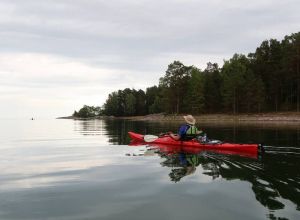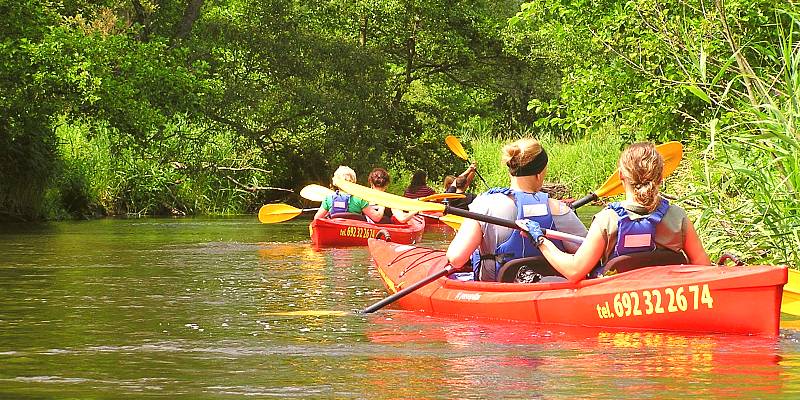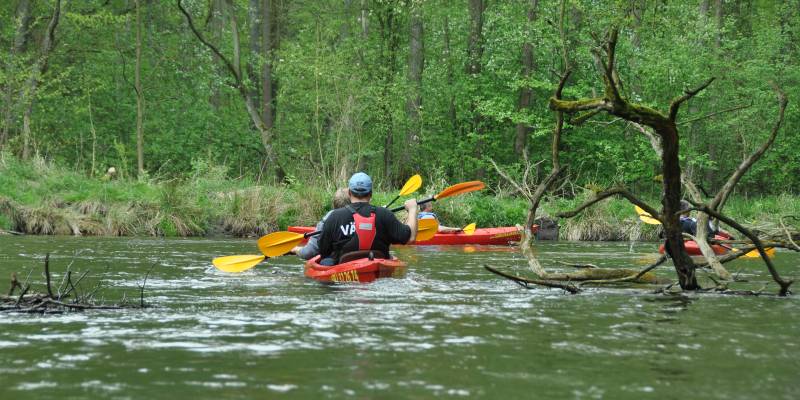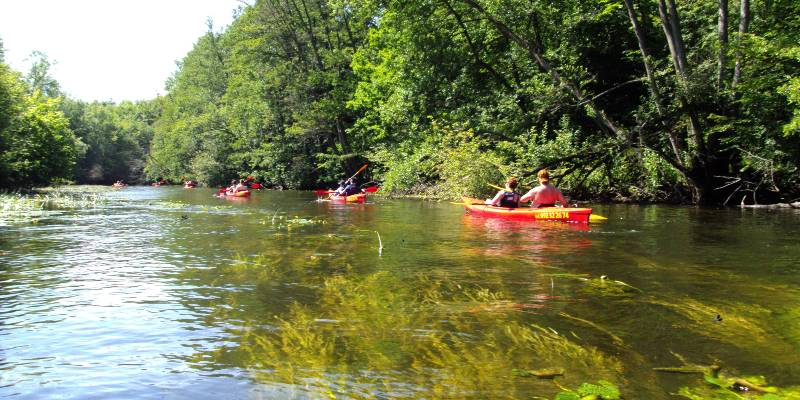Kayaking courses and trainings - eskimo roll, white water and sea kayaking.
Training basics of white water kayaking
This training will allow you to feel safe and secure in a one-person kayak not only on ww rivers, but also on lowland rivers, rolled rivers or a lake. The training includes rowing techniques, water safety rules, an overview of the necessary equipment and the basics of self-reinsurance in a kayak.
This course will teach you, among other things:
- How to get in and out of a single person's kayak on a steep bank, rowing techniques.
- ABC of specialized equipment - what is worth knowing before buying it and how to use it
- "flat and tall support" - how to properly belay yourself in order not to overturn the kayak
- "cabin" - that is correct and safe evacuation from the kayak
- "the beak and the hand of God" - How to turn an overturned kayak when we fell out of the paddle or are unable to get up by "eskimo roll".
- entering and leaving the kayak on "open water"
- methods of overcoming obstacles without getting out of the kayak (e.g. through fallen trees into the river)
White water training course
This training is aimed at people who have previous experience in single-handed kayaking and who would like to learn more advanced techniques. The acquired skills will allow you to move freely on lowland rivers, (with lots of fallen trees across the river) and white water rivers. In this course you will also learn about extended kayaking self-insurance techniques, safety and rescue on the water, and techniques for swimming on ww.
Among other things, you will learn:
- entry and exit from the upstream and downstream current entry to the "back" (the reverse current on the river, usually behind an obstacle) with the "flat and hook" counter
- canoeing hall and pouring water when we can't go ashore or we are in the middle of the water
- how to proceed in the so-called "cabin", i.e. what to do to reach the shore safely without losing health and equipment
- "feathering" - you can not only swim forwards or backwards in a kayak, there is also an effective technique of swimming sideways
- "eskimo roll", i.e. 360° rotation in a kayak* and for those willing to do so, eskimo roll on their own hands without a paddle
- methods of rescue from the land, i.e. how to use the rescue dart and the "man frog" as an element of securing hard to overcome places on the river (such as the "dashboard")
- the basics of pre-medical first aid
Course and training in sea kayaking
This training is addressed to people who would like to learn how to kayak the sea safely and independently. Acquired skills will help you move safely through large bodies of water. On this course we will also teach you the techniques of sea kayaking, kayaking self-reinsurance, safety and rescue.
Among other things, you will learn:
- how to get in and out of a sea kayak at high shore properly
- rowing techniques
- ABC of specialized equipment - what is worth knowing before buying it and how to use it
- "flat and tall support" - how to properly belay yourself in order not to overturn the kayak
- "cabin" - that is correct and safe evacuation from the kayak
- "the beak and the hand of God" - How to turn an overturned kayak when we fell out of the paddle or are unable to get up the so-called "Eskimo roll".
- entering and leaving the kayak on "open water"
- canoeing hall and pouring water when we can't go ashore or we are in the middle of the water
- how to proceed in the so-called "cabin"
- "feathering" - you can not only swim forwards or backwards in a kayak, there is also an effective technique of swimming sideways
- "Eskimo roll", i.e. 360° rotation in a kayak*
- rescue methods
- the basics of pre-medical first aid
Price list for canoeing training
| Type of training | Place | Min. no of trainee | Duration | Price per person |
|---|---|---|---|---|
| Basics of white water kayaking | Rega lub Drawa | 2 person | 3-4 h | from 200 PLN |
| Sea kayaking | Szczecin lub Bałtyk | 1 person | 3-4 h | from 200 PLN |
| White water kayaking | Drawa | 2 person | 3-4 h | from 200 PLN |
Frequently asked questions
1. How to paddling?
The correct paddling technique consists primarily in the correct rowing position (back straight, slightly leaning forward, legs resting on footrests) and we paddle alternately holding on to the principle that the lower hand pulls the paddle bar and the upper hand pushes away so that we paddle using also the back muscles.
It is best to ask our staff for details during the canoeing briefing.
2. How to steer the kayak?
There are several methods. In a two-person kayak, we paddle on one side (forwards, i.e. we push the water back towards the stern of the kayak with an oar, and on the other side, similarly, in the opposite direction (backwards, i.e. we push the water back towards the bow with an oar or hold the pen in the water on the current on stiffened hands). We can also use the so-called control contours etc. It will be best to ask our staff about the details during the canoeing briefing.
3. What to do if we have an accident on the kayak and swimming?
Above all, this should not be allowed to happen. However, if this happens, you should get out of the kayak (which we often do automatically) and while holding on to the kayak we sail with it to the nearest shore. If it is shallow, you can pour out the water in the place of the overturn, and then get into it providing yourself with additional support of the other kayak, shore or obstacle. On the lake it is quite difficult to overturn the kayak if you are sitting in it, but if you have already done it, the kayak overturned upside down has an air cushion inside, thanks to which the kayak floats on the water surface and we can sail with it to the nearest shore (preferably with the wind). With the help of other kayaks you can even pour water out of the overturned kayak by leaning it on the cockpit of the kayak supporting the rescue operation. A detailed technique of how to do this will be best explained by our staff during the briefing or you can enroll in a special kayaking course and experience it in practice.
Recommended Kayaking Routes
Kayaking Rega River Among many kayakers, Rega is considered to be one of the most attractive rivers in West Pomerania. The fourth longest river in Poland, which flows directly into the Baltic Sea, makes it extremely attractive especially for those who appreciate the proximity of wildlife and diverse character of the river during rafting.
Price: from 40 PLN/person
Difficulty: easy some difficult
Routes: 11
Length: 9-36 km
Kayaking Drawa River Drawa is one of the most beautiful kayaking trails in Poland. Clean water, picturesque lakes and diverse river sections attract kayaking enthusiasts from all over Poland. The Drawa is neither too difficult nor too burdensome, although there are mountainous sharks, obstacles and blockages, as well as trees sunk across the riverbed.
Price: from 40 PLN/person
Difficulty: easy some difficult
Routes: 10
Length: 10-35 km
Kayaking Ina River Ina is one of the most picturesque and interesting rivers in the West Pomeranian Lakeland visited by kayakers. The most popular and most visited kayaking routes are located near Goleniów and Sowno. Despite its natural values, it is not as crowded by tourists as other local rivers.
Price: from 40 PLN/person
Difficulty: easy
Routes: 5
Length: 9-30 km
































